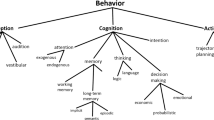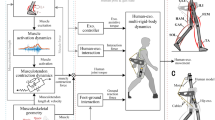Abstract
Reweighting sensory information adaptively is considered critical for flexible postural control, but little is known of the time scale of the reweighting process. We analyzed the transient dynamics of sensory reweighting in a previously published nonlinear adaptive model of sensory integration in the human postural control system. The model’s dynamics of adaptation were tested in response to abrupt changes in the amplitude of the motion of the visual surround. In addition to qualitatively reproducing the correct asymptotic response to such changes in visual amplitude, as previously found, the model qualitatively reproduced the asymmetric transient response elucidated in recent experiments (Oie et al. in Gait Posture 2005). In particular, the model adapts at an initially rapid rate to a switch from low to high amplitude visual motion, but at an initially slower rate upon the return to low amplitude motion. The observed temporal asymmetry has potential functional value. Rapid downweighting of a visual stimulus that suddenly increases is necessary to prevent loss of upright equilibrium. A visual stimulus that decreases in amplitude does not pose a threat to upright balance, allowing for slower upweighting without functional consequence.
Similar content being viewed by others
References
Andersen RA, Buneo CA (2003) Sensorimotor integration in the posterior parietal cortex. Adv Neuro 93:159–177
Anderson JA (1995) An introduction to neural networks. MIT, Cambridge
Arnold L (1974) Stochastic differential equations: theory and applications. John Wiley, NewYork
Astrom KJ, Wittenmark B (1995) Adaptive control. Addison-Wesley, Reading
Carver S, Kiemel T, van der Kooij H, Jeka J (2005) Comparing internal models of the dynamics of the visual environment. Biol Cyber 92:147–163
Fairhall AL, Lewen GD, Bialek W, de Ruyter van Steveninck RR (2001) Efficiency and ambiguity in an adaptive neural code. Nature 412:787–792
Hay L, Bard C, Fleury M (1996) Availablity of visual and proprioceptive afferent messages and postural control in elderly adults. Exp Brain Res 108:129–139
Horak FB, Shupert C, Mirka A (1989) Components of postural dyscontrol in the elderly: a review. Neurobio Aging 10(6):727– 738
Kiemel T, Oie KS, Jeka JJ (2002) Multisensory fusion and the stochastic structure of postural sway. Biol Cybern 87:262–277
van der Kooij H, Jacobs R, Koopman B, Grootenboer H (1999) A multisensory integration model of human stance control. Biol Cyb 80:299–308
van der Kooij H, Jacobs R, Koopman B, van der Helm F(2001) An adaptive model of sensory integration in a dynamic environment applied to human stance control. Biol Cybern 84:103–115
Kuo A (1995) An optimal control model for analyzing human postural balance. IEEE Trans Biomed Eng 42(1):87–101
Lee DN, Lishman JR (1975) Visual proprioceptive control of stance. J Human Movement Studi:87–95
Mergner T, Maurer C, Peterka RJ (2003) A multisensory model of human upright stance. In: Prablanc C, Pelisson D, Rossetti Y (eds) Progress in brain research, vol 142, chap 12. Elsevier,
Oie KS, Kiemel T, Jeka JJ (2002) Mulisensory fusion: simultaneous re-weighting of vision and touch for the control of human posture. Cognitive Brain Res 14:164–167
Oie K, Carver S, Kiemel T, Barela J, Jeka J (2005) The dynamics of sensory reweighting: a temporal asymmetry. Gait Posture 21(1): S29
Peterka RJ (2002) Sensorimotor integration in human postural control. J Neurophysiol 88:1097–1118
Peterka RJ, Benolken MS (1995) Role of somatosensory and vestibular cues in attenuating visually induced human postural sway. Exp Brain Res 105:101–110
Teasdale N, Stelmach GE, Breunig A (1991) Postural sway characteristics of the elderly under normal and altered visual and support surface conditions. J Gerontol 46(6):B238–B244
Wade MG, Lindquist R, Taylor JR, and Treat-Jacobson D (1995) Optical flow, spatial orientation and the control of posture in the elderly. J Gerontol Psychol Sci 50B(1):P51–P58
Wallace MT, Meredith A, Stein BE (1998) Multisensory integration in the superior colliculus of the alert cat. J Neurophysiol 80:1006–1010
Wilson VJ, Melvill Jones G (1979) Mammalian vestibular physiology. Plenum, NewYork
Woollacott MH, Shumway-Cook A, Nashner L (1986) Aging and postural control: changes in sensory organization and muscular coordination. Int J on Aging Human Dev 23(2):97–114
Author information
Authors and Affiliations
Corresponding author
Rights and permissions
About this article
Cite this article
Carver, S., Kiemel, T. & Jeka, J.J. Modeling the Dynamics of Sensory Reweighting. Biol Cybern 95, 123–134 (2006). https://doi.org/10.1007/s00422-006-0069-5
Received:
Accepted:
Published:
Issue Date:
DOI: https://doi.org/10.1007/s00422-006-0069-5




